
Umweltschutz am Standort Pirdop
Aurubis Bulgarien ist der größte Kupferproduzent Südosteuropas und das zweitgrößte Unternehmen des Landes. Seit der offiziellen Eröffnung des Standortes in Pirdop im Jahr 1958 werden hier hauptsächlich Kupferanoden, Kupferkathoden und Schwefelsäure aus Primärrohstoffen produziert.
In den letzten zwei Jahrzehnten wurde das Werk zu einem hochmodernen und umweltfreundlichen Betrieb umgebaut. Seit der Übernahme durch Aurubis im Jahr 2008 bis heute wurden etwa 165 Mio. € in die Modernisierung der Prozesse und die Verbesserung der Umweltleistung des Standortes investiert.
Die Verbesserung im Umweltschutz bleibt auch weiterhin ein sehr wichtiges Ziel, und so wurden in den letzten fünf Jahren ca. 20 % (~75 Mio. Euro) sämtlicher Investitionen am Standort für Umweltschutzprojekte aufgewendet.
Im Zuge der umfangreichen Modernisierungen wurden in den letzten Jahren insbesondere drei bedeutende Umweltschutzanlagen gebaut, die dem neuesten Stand der Technik entsprechen. Im November 2014 wurde eine neue Regenwasseraufbereitungsanlage in Betrieb genommen. Die Anlage behandelt Regen- und Drainagewasser des 4 km² großen Firmengeländes, um die Wasseremissionen weiter zu reduzieren.
Ein neues, zusätzliches Behandlungssystem für Sekundärhaubenabgase ist seit März 2016 im Betrieb. Das neue System arbeitet mit einem modernen Verfahren, der sogenannten Sulfacid-Technologie, die einzigartig für Bulgarien und die gesamte Kupferhüttenindustrie ist.
Darüber hinaus wurde ein neues Projekt zur Optimierung der Konverterschlackenkühlung (Topfkühlung anstelle von Grubenkühlung) eingeführt und Anfang 2020 in Betrieb genommen. Diese neuen Anlagen reduzieren die Schwefeldioxid- und die diffusen Emissionen aus den Verhüttungsprozessen weiter. Dieses Projekt wird in den kommenden Jahren erweitert, um auch die Kühlung der Schlacken aus dem Schwebeschmelzofen zu optimieren. Die Genehmigung für die Erweiterung wurde im Juli 2024 ausgestellt und im September des gleichen Jahres wurde mit dem Bau begonnen. Im Rahmen des Projekts werden auch mehr als 11000 m² Grünflächen saniert.
Aurubis übernimmt Verantwortung für den Umweltschutz. Das Werk befindet sich in der Nähe von Naturschutzgebieten, die nächstgelegenen Gebiete sind Tsentralen Balkan - bufer in ca. 1 km Entfernung und Sregdna Gora in ca. 2 km Entfernung. Der Schutz der Natur und Biodiversität sind Teil unserer Umweltziele, und Aurubis Bulgarien hat Maßnahmen zur Verbesserung der Lebensraumbedingungen von Pflanzen und Tieren definiert. Beispielsweise werden in Eigeninitiative Flächen wiederhergestellt, indem Gräser, Sträucher und Bäume gepflanzt werden. Stillgelegte Deponieflächen auf dem Gelände werden im Rahmen der Schließung renaturiert. Andere Umweltprojekte zur weiteren Reduktion von Emissionen wirken sich ebenfalls positiv auf die Umwelt aus. Zum Beispiel verbessert die Reduzierung der Metallemissionen in Gewässer, die seit dem Jahr 2000 um über 98 % gesenkt werden konnten, die Lebensraumbedingungen in den Flüssen.
Seit 2006 hat Aurubis Bulgarien ein Umweltmanagementsystem nach der Norm ISO 14001 eingeführt. Die letzte Rezertifizierung wurde im März 2024 erfolgreich abgeschlossen. Die im Rahmen der Zertifizierung des Managementsystems durchgeführten externen Audits, umfassen eine Überprüfung der Umweltdaten, der Erfüllung der gesetzlichen Vorschriften und der Wirksamkeit der betrieblichen Prozesse. In der zweiten Jahreshälfte 2022 wurden am Standort Pirdop zudem das Energiemanagementsystem nach ISO 50001, das Arbeitsschutzmanagementsystem nach ISO 45001 und das Qualitätsmanagementsystem eingeführt.
In Pirdop wird seit dem Jahr 2011 ein Informationszentrum betrieben, das von der Bevölkerung zur Information genutzt wird. Die Umweltmonitoring-Daten sind auch bei den Gemeinden Pirdop und Zlatitza auf Monitoren öffentlich einsehbar.
Die Ergebnisse des Umweltmonitorings werden an die Behörden übermittelt. Die jährlich erstellten Berichte sind auf der Homepage der Bulgarian Executive Environment Agency einsehbar.
Der Standort in Pirdop fällt seit 2008 unter das EU-Emissionshandelssystem und hat seine Energieeffizienz im Laufe der Jahre kontinuierlich verbessert. Aurubis Bulgarien strebt auch in Zukunft weitere Investitionen in Umweltmaßnahmen und Energieeffizienzverbesserungen an.
Umweltschutz Pirdop - Daten & Fakten

SO2-Emissionen [kg/t] pro erzeugter Tonne Kupfer
Die SO2-Emissionen pro erzeugter Tonne Kupfer konnten seit dem Jahr 2000 um 95 % reduziert werden.

Staubemissionen [kg/t] pro erzeugter Tonne Kupfer
Die Staubemissionen pro erzeugter Tonne Kupfer konnten seit dem Jahr 2000 um 99,5 % reduziert werden.
Maßgeblich für die Reduzierung der Emissionen waren:
- zahlreiche Modernisierungen beider Stränge der Schwefelsäureanlage (2001 - 2014)
- der Ersatz der Schweröltrockner durch Dampftrockner (2001 – 2002)
- das erste (konventionelle) Abgasreinigungssystem für Sekundärhaubenabgase (2007)
- das neue zusätzliche (Sulfacid) Abgasreinigungssystem für Sekundärhaubenabgase (2016).
- die neue Anlage zur Kühlung von Konverterschlacke in Töpfen (2020)
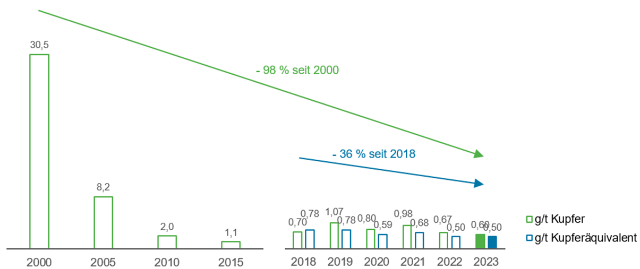
Metallemissionen in g/t erzeugten Kupfers und in g/t Kupferäquivalent
Die spezifischen Metallemissionen in Gewässer pro erzeugter Tonne Kupfer konnten seit dem Jahr 2000 um 98 % reduziert werden.
Maßgeblich für die Reduzierung der Metallemissionen in Gewässer waren:
- die Inbetriebnahme der zweiten und dritten Stufe der Behandlungsanlage für industrielle Abwässer (2005 - 2006)
- die Modernisierung des Abwassersystems für saure Abwässer (2006 - 2008)
- die Modernisierung der Abwassersysteme für Haushaltsabwässer (2010 - 2011) und Regenwasser (2012 - 2013)
- die Inbetriebnahme der Aufbereitungsanlage für Regenwasser (2014).
- die Inbetriebnahme eines neuen Sandfilters in der Anlage zur Reinigung von Prozessabwasser (2020).
Durch ein neues Verfahren im Rahmen der geplanten Modernisierung der Abwasseraufbereitungsanlage am Standort Pirdop soll die Menge der zu deponierenden Schlämme (die bei den Produktionsprozessen in Pirdop anfallen) und der Chemikalienverbrauch verringert werden. Dies wird die Nutzungsdauer der Schlammdeponie verlängern und die Kapazität der Abwasserbehandlunganlage erhöhen, um eine möglichst effiziente Abwasserbehandlung zu gewährleisten. Das Projekt befindet sich seit September 2024 im Bau, die Inbetriebnahme ist in Q1 2026 geplant.
Maßnahmen & Projekte im Umweltschutz
Implementierungsgrad
- Bau einer neuen Anlage zur Kühlung der Konverterschlacke in Töpfen.
- Baugenehmigung im Februar 2018 erhalten
- Inbetriebnahme Anfang 2020
Status:
- Abgeschlossen
- Erweiterung des Projekts, um die Kühlung der Schlacken aus dem Schwebeschmelzofen zu optimieren bis Q3 2025 vorgesehen
Implementierungsgrad
-
Installation eines neuen Sandfilters in der bestehenden Behandlungsanlage für industrielle Abwässer
- Inbetriebnahme 2020
Status:
- Abgeschlossen
Nächste Schritte:
- Optimierungsmöglichkeiten wurden untersucht
- Umsetzung erfolgte während der Anlageninstandsetzung (Q2 2019)
Status:
- Abgeschlossen: Vorhandene Filteranlage modifiziert und zusätzliche Filterboxen installiert
Nächste Schritte:
- Baugenehmigung erhalten
- Renaturierung ist abgeschlossen
Status:
- Abgeschlossen in Q3 2021
Umsetzungsgrad:
- Unterzeichneter Vertrag mit CEZ ESCO Bulgaria für den Bau eines Photovoltaik-Kraftwerks (10 MW) auf dem Gelände einer sanierten Deponie
- Detailplanung für Solarpark Nummer 2 und 3 abgeschlossen
Status:
-
Abgeschlossen. Der Solarpark wurde im März 2023 in Betrieb genommen.
-
Errichtung begann in Q1 2024
Meilensteine im Umweltschutz am Standort Pirdop
Im Rahmen unserer langfristigen Unternehmensstrategie „Metals for Progress: Driving Sustainable Growth“ haben wir im April 2024 mit dem Bau von zwei zusätzlichen Photovoltaikparks an unserem Standort Pirdop, Bulgarien, begonnen. Eine weitere Ausbaustufe ist bereits genehmigt. Damit erweitern wir den seit 2021 bestehenden Solarpark vor Ort und investieren erneut in die Dekarbonisierung unserer Produktion. Die Maßnahmen werden bis 2024/25 umgesetzt.
Mit den insgesamt vier Photovoltaikanlagen steigern wir die Eigenstromerzeugungskapazitäten deutlich und können künftig etwa 15 % des Strombedarfs des Standorts mit grüner Energie decken. So werden wir jährlich rund 55.000 MWh Strom erzeugen, was dem Bedarf einer Stadt mit 25.000 Einwohnern entspricht. Zudem sparen wir rund 25.000 t CO2-Emissionen pro Jahr ein.

Im Juli 2020 wurde der Vertrag mit CEZ ESCO Bulgaria EOOD, einem Unternehmen der CEZ-Gruppe, unterzeichnet. Die Photovoltaikanlage Aurubis-1 am Standort Pirdop reduziert den externen Energieverbrauch der Hütte um 11.000 MWh jährlich. Der erzeugte Strom entspricht dem Jahresbedarf von 3.500 Haushalten oder einer Stadt mit 14.000 Einwohnern. Im Vergleich zum Einsatz von Kohlestrom werden dadurch die CO2-Emissionen um 15.000 t pro Jahr - und über 225.000 t für die geplante Betriebsdauer - reduziert.
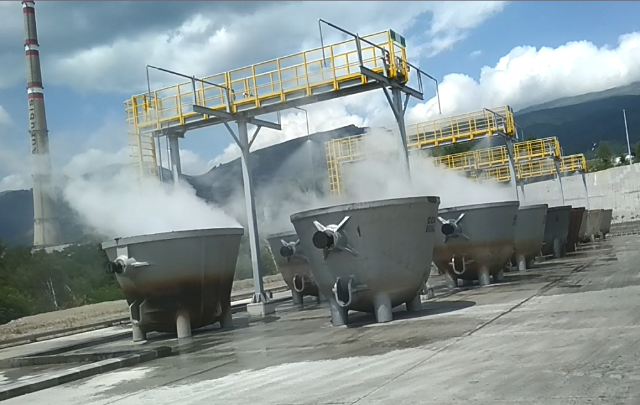
Optimierung der Kühlung von Konverterschlacke: Eine neue Anlage zur Kühlung von Konverterschlacke in Töpfen wurde Anfang 2020 in Betrieb genommen. Dieses Projekt wird in den kommenden Jahren erweitert, um auch die Kühlung der Schlacken aus dem Schwebeschmelzofen zu optimieren
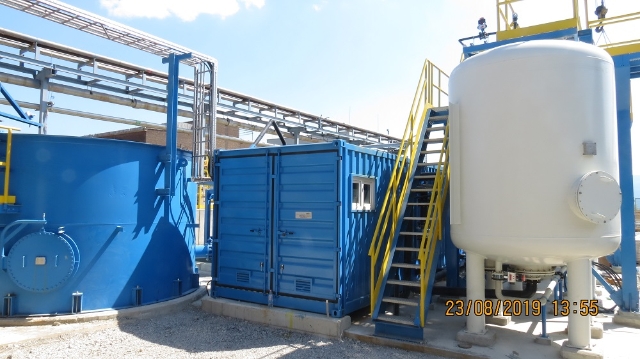
Umbau der industriellen Kläranlage: Ein neuer Sandfilter in der Anlage zur Reinigung von Prozessabwasser wurde installiert, um die Einleitung von ungelösten Stoffen in Gewässer zu reduzieren.
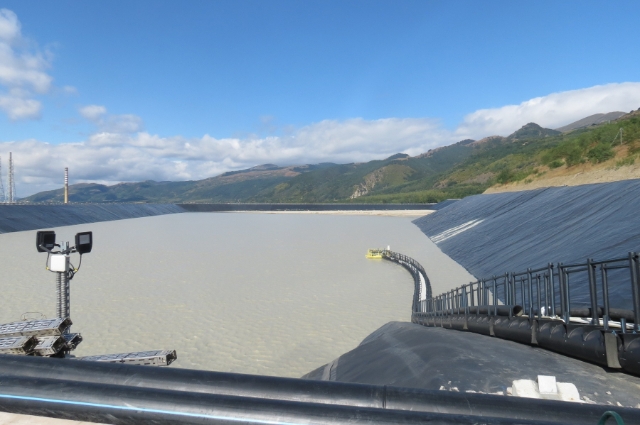
Erweiterung der Fayalit-Deponie: Die erste Stufe der Erweiterung der Fayalit-Deponie wurde im Mai 2018 fertiggestellt und in Betrieb genommen. Das Projekt sieht eine Erweiterung der bestehenden Fayalit-Deponie, die aus zwei Zellen mit einer Gesamtkapazität von ca. 19,8 Millionen Tonnen besteht vor. Die Zellen sind von Erddeichen umgeben, die durch eine Isolierschicht geschützt und mit Entwässerungssystemen ausgestattet sind. Jede Zelle wird in acht separaten Stufen bis zur Höhe der bestehenden Fayalit-Deponie gebaut.
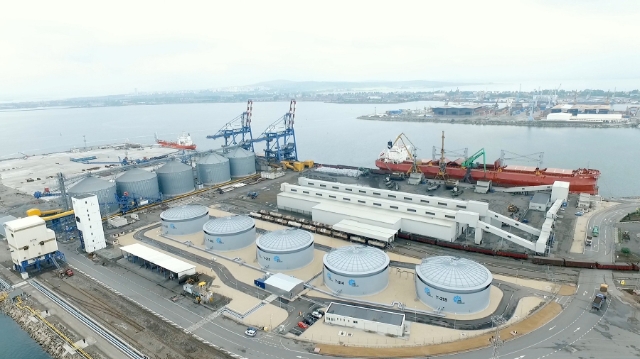
Spezialterminal für den Umschlag und die Lagerung von Schwefelsäure im Hafen von Burgas: Ein neues Terminal für den Umschlag und die Lagerung von Schwefelsäure wurde im Hafen von Burgas am Schwarzen Meer offiziell eingeweiht. Die gesamte Lagerkapazität beträgt 50.000 Tonnen Schwefelsäure. Beide Projekte (das Terminal für Schwefelsäure und das Lager für Kupferrohstoffe) wurden in Zusammenarbeit mit dem größten privaten Hafenbetreiber Bulgariens - BMF Port Burgas - realisiert.

Lager für Kupferrohstoffe im Hafen von Burgas: Im Mai 2017 wurde bei BMF Port Burgas ein neues Lager für Kupferrohstoffe eröffnet. Das Lager verfügt über eine Lagerkapazität von 65.000 Tonnen Kupferkonzentrat und umfasst eine Fläche von 6.000 Quadratmetern. Der Schwerpunkt dieses Projekts betrifft die Verbesserung der Umweltleistung zum Schutz der Luft. Die neuen Anlagen ermöglichen den Transport und die Lagerung der Kupferkonzentrate in geschlossenen Räumen, wobei das Schüttgut ohne Verluste behandelt wird. Die derzeitigen Einrichtungen entsprechen den besten verfügbaren Techniken (BVT).
Seveso-Genehmigung erteilt: Im August 2017 hat Aurubis Bulgaria erfolgreich die Seveso-Genehmigung gemäß der Richtlinie 2012/18 / EG (SEVESO III) erhalten.
Schließung der dritten Schlammdeponie: Ähnlich wie die ersten und der zweiten Schlammdeponie wurde die dritte Schlammdeponie für Schlämme der Abwasser- und Abgasbehandlung erfolgreich in Übereinstimmung mit den Planungen und allen anwendbaren Umweltanforderungen (insbesondere Richtlinie 1999/31 / EG) geschlossen. Die geschlossene Deponie wird nun die den nächsten mindestens 30 Jahren überwacht, um sicherzustellen, dass alle Sanierungsarbeiten erfolgreich waren.
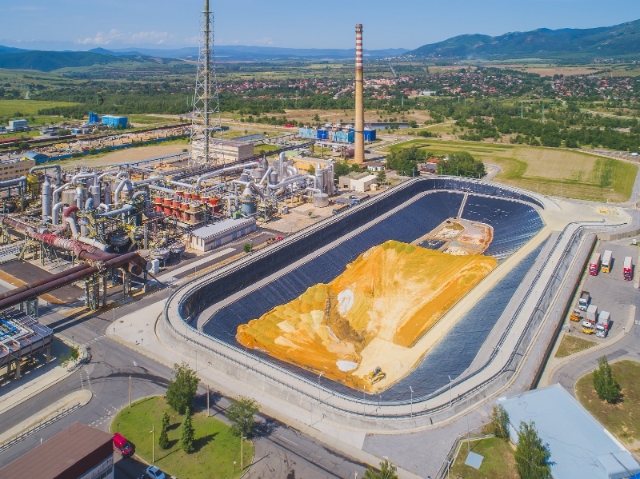
Bau der vierten Schlammdeponie: Die vierte Spezialdeponie für Schlämme der Abwasser- und Abgasbehandlung wurde in voller Übereinstimmung mit allen relevanten Umweltanforderungen (insbesondere der Richtlinie 1999/31 / EG) errichtet und in Betrieb genommen.
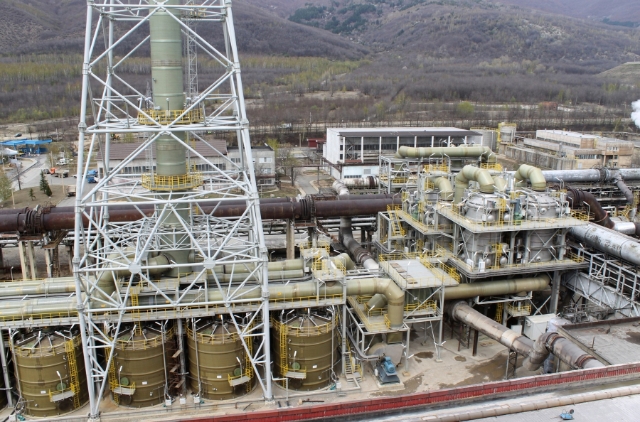
Neue, zusätzliche Behandlungsanlage für Sekundärhaubenabgase (Sulfacid): Das neue Gasreinigungssystem (Sulfacid) wurde in voller Übereinstimmung mit der besten verfügbaren Technik (BVT) gebaut und in Betrieb genommen. Das Projekt leistet einen erheblichen Beitrag zum Umweltschutz. Es verwendet ein modernes Verfahren, eine Technologie namens Sulfacid, die für Bulgarien und für die gesamte Kupferhüttenindustrie einzigartig ist.
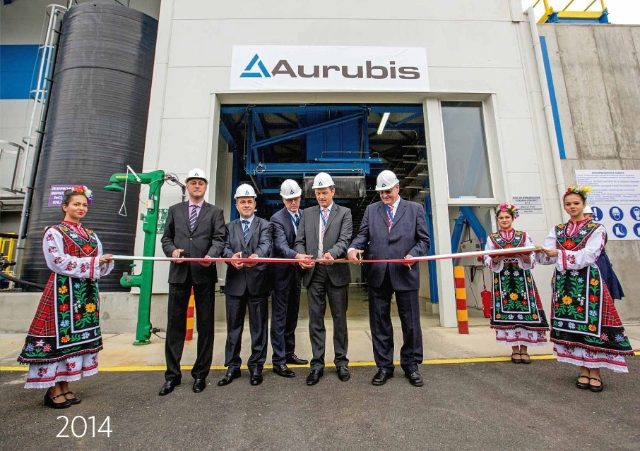
Eröffnung einer Regenwasseraufbereitungsanlage: Die von Aurubis getätigten Gesamtinvestitionen für die Behandlungsanlage für Regen- und Drainagewasser belaufen sich auf 6,3 Mio. €. Die Bauphase erstreckte sich über ein Jahr und umfasste den Bau der Anlage mit einer Kapazität von 250 m³/h und Auffangbecken für anfallende Abwässer. Um die Emissionen in Wasser nachhaltig zu senken, reinigt die Anlage das Regen- und Drainagewasser des Geländes, das eine Fläche von 4 km² aufweist. Die Anlage entspricht der besten verfügbaren Technik (BVT).
Nutzung von Abfallstoffen und Einführung eines neuen Produkts in das Portfolio: Ende 2012 wurden Zuschüsse von der EU an Aurubis Bulgaria für ein Projekt zum Recycling von Abfallstoffen und zur Einführung eines neuen Produkts (Fayalit / feinkörniges Eisensilikat) in das Portfolio genehmigt. Das Projekt wurde von der EU aus dem Fonds für regionale Entwicklung im Rahmen des Programms „Entwicklung der Wettbewerbsfähigkeit der bulgarischen Wirtschaft“ (2007–2013) zusammen mit dem bulgarischen Staat finanziert. Die finanzielle Unterstützung von 50 % ist vertraglich gewährleistet und bezieht sich auf den Programmpunkt „Investitionen in grüne Industrien“ des regionalen Entwicklungsprogramms. Das Projekt umfasst unter anderem die Beschaffung und die Inbetriebnahme von neuer Ausrüstung für die Kupferschrottaufbereitung sowie eine Filterpresse für die Trocknung von Fayalit, die weitere Möglichkeiten für eine Nutzung dieses Nebenprodukts eröffnet.
Investitionsprogramm „Aurubis Bulgaria 2014“: Das Projekt mit einem Umfang von 44,2 Mio. € beinhaltete Umweltschutzmaßnahmen in Höhe von 26 Mio. € und zielte neben Verfahrensverbesserungen darauf ab, die Umweltbilanz der Schmelzbetriebe weiter zu verbessern. Verbesserungen wurden unter anderem durch die Erweiterung der Filterkapazität für die Konzentrat-Trocknungsanlage, den Austausch des Brenners für das Konzentrat, eine Erweiterung der Kühlanlage des Schmelzofens sowie durch Modifizierung und Erhöhung der Wärmeaustauschkapazität des Abhitzekessels erzielt. Die Errichtung der neuen, zusätzlichen Behandlungsanlage für Sekundärhaubenabgase stellt einen maßgeblichen Beitrag des Projekts zum Umweltschutz dar.
Wiedereröffnung der erneuerten Flotationsanlage für Schlacke: Neben der Erhöhung der Schlackenverarbeitungskapazität wurde auch die Rückgewinnungsrate für Kupfer gesteigert, was die Ressourceneffizienz des Standorts weiter verbessert. In der Anlage wird die beste verfügbare Technik eingesetzt.

Eröffnung der neuen Elektrolyse: Die neue Elektrolyse läuft mit vollautomatischen Anlagen und entspricht gemäß der Norm ISA 2000 (Australien) dem neuesten Stand der Technik. Der Prozessablauf wird durch ein automatisches Managementsystem (DCS 7) kontrolliert und geregelt. Die Gesamtkosten für den Bau der Elektrolyse beliefen sich auf 82 Mio. € und stellen somit die größte industrielle Investition in Bulgarien dieser Zeit dar.
Bau der dritten Schlammdeponie: Die dritte Deponie für Schlämme aus der Abwasser- und Abgasbehandlung wird errichtet und in Betrieb genommen. Auch hier werden die höchsten Sicherheitsstandards zum Schutz von Boden sowie Oberflächen- und Grundwasser gewährleistet (insbesondere Richtlinie 1999/31/EC).

Erstes konventionelle Behandlungssystem für Sekundärhaubenabgase: In 2008 wurde das erste konventionelle Behandlungssystem für Sekundärhaubenabgase in voller Übereinstimmung mit den besten verfügbaren Techniken (BVT) offiziell in Betrieb genommen. Das System senkt die Emissionen von Feinstaub und Schwefeldioxid deutlich. Die Gesamtinvestition des Projekts betrug 14 Mio. € und wurde von Aurubis finanziert.
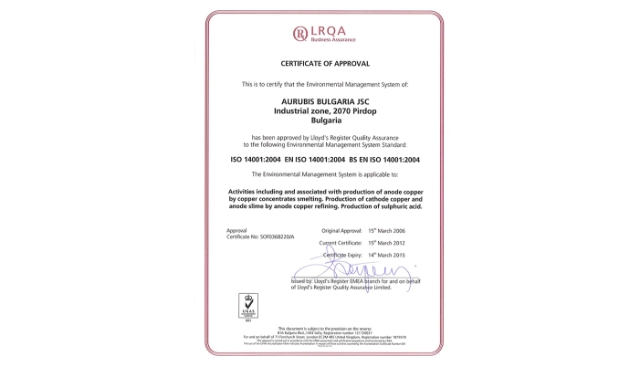
Zertifizierung des Umweltmanagementsystems nach ISO 14001: Im März 2006 wurde das Umweltmanagementsystem des Standortes Pirdop zum ersten Mal erfolgreich von einem externen Auditor nach der Norm ISO 14001 zertifiziert.
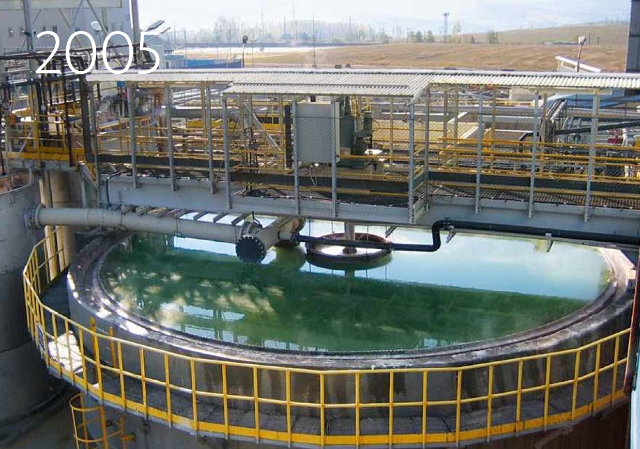
Eröffnung der zweiten und dritten Stufe der Behandlungsanlage für industrielle Abwässer: Im Mai 2005 wurden die zweite und dritte Stufe der Behandlungsanlage für industrielle Abwässer in Betrieb genommen. Sie verwenden eine moderne Technologie, die für die Behandlung von Industrieabwässern in einem dreistufigen Verfahren entwickelt wurde und die Einhaltung der Grenzwerte für Wasseremissionen garantiert.
Aufrüstung der Schwefelsäureanlage: Die schwefeldioxidreichen Gase, die während der Verhüttung des Kupferkonzentrats im Schwebeschmelzofen und an den Konvertern entstehen, werden in der Schwefelsäureanlage gereinigt, getrocknet und in Schwefelsäure überführt. Die Anlage besteht aus zwei gleichen Teilanlagen, die vollautomatisch konzentrierte Schwefelsäure produzieren. Diese wird sowohl intern weiterverwendet als auch verkauft und externer Nutzung zugeführt.
Umsetzung der Richtlinie zur integrierte Vermeidung und Verminderung der Umweltverschmutzung (IVU-Richtlinie): Im Juni 2005 wurden die Umweltschutzmaßnahmen des Werks mit einer Genehmigung gemäß der europäische IVU-Richtlinie (engl. IPPC) über die integrierte Vermeidung und Verminderung der Umweltverschmutzung anerkannt.
Bau der zweiten Schlammdeponie: Auch die zweite Deponie, die speziell für die Schlämme aus der Abwasser- und Abgasbehandlung gebaut wurde, erfüllt sämtliche Umweltanforderungen und höchste Sicherheitsstandards zum Schutz von Boden und Grundwasser (insbesondere gemäß Richtlinie 1999/31/EC).
Belgischer Umweltschutzpreis: Die erfolgreiche Vollendung des Umweltsanierungsprogramms in Pirdop wurde mit dem belgischen Umweltschutzpreis 2003/2004 in der Kategorie „Internationale Zusammenarbeit für nachhaltige Entwicklung“ ausgezeichnet.

Bau einer Fayalitdeponie: Für die Lagerung von Fayalit, das beim Flotationsprozess anfällt, wurde eine Deponie gebaut, die sämtliche Anforderungen an den Umweltschutz erfüllt. Die erste und zweite Erweiterung der Deponie wurde 2009 bzw. 2015 fertiggestellt.
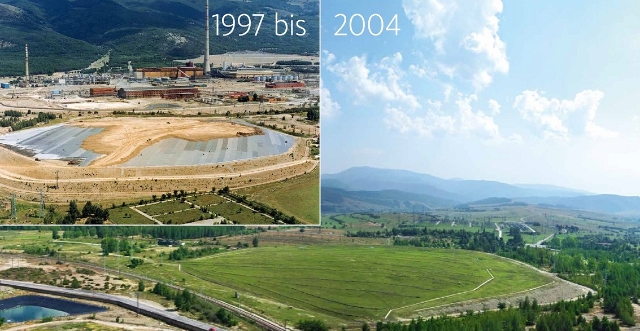
Umweltsanierungsprogramm: Das Hüttenwerk „Georgi Damyanov“ wurde von 1958 bis 1997 als staatseigenes Unternehmen betrieben. Wegen unzulänglicher Investitionen in den Umweltschutz seitens des bulgarischen Staats kam es in dieser Zeit in der Region zu erheblichen Auswirkungen auf die Umwelt. 1997 wurde das Unternehmen privatisiert und seitdem von der belgischen Union Minière Group geführt. Der Vertrag zur Privatisierung beinhaltete unter anderem ein Sanierungsprogramm im Umfang von 25 Mio. US$. Im Rahmen dieses Programms wurden stillgelegte Anlagen abgerissen, der Bauschutt fachgerecht entsorgt und Deponieflächen (der Schlammteich, auch bekannt als „Blaue Lagune“, die Fayalitdeponie, die Schlackedeponie) sowie kontaminiertes Erdreich saniert. Im Rahmen des Sanierungsprogrammes wurden 1999 auch die erste Stufe der Behandlungsanlage für industrielle Abwässer und die erste Deponie für Schlämme aus der Abwasser- und Abgasbehandlung errichtet und in Betrieb genommen.
Zertifikate Aurubis Bulgaria
-
Um die heruntergeladene Komponente zu sehen den QR code scannen
ISO 9001: 2015
PDF
1 MB
-
Um die heruntergeladene Komponente zu sehen den QR code scannen
ISO 14001: 2015
PDF
1 MB
-
Um die heruntergeladene Komponente zu sehen den QR code scannen
ISO 45001 : 2018
PDF
1 MB
-
Um die heruntergeladene Komponente zu sehen den QR code scannen
ISO 50001 : 2018
PDF
2 MB

Angel Kostov
Umweltmanager
| Telefon | +359 728 62-203 |
| Mobil | +359 885 350 284 |

Krasimir Slavov
Umweltmanager Operations
| Telefon | +359 728 62-514 |
| Mobil | +359 887 707 524 |